It's all about Harriet. Harriet Osprey has been the one constant throughout the years since we installed our web camera above her nest. She delights us. She amazes us. Her endurance, perseverance, dedication, strength, and total commitment to life have earned our respect, our admiration, and, yes, our love.
How is it that you can love an animal that you know only from afar, that you will never touch, and that knows you only as a two-legged being walking beneath her world and cares nothing about you? But I am not alone in my affections. Indeed, others who have never seen her personally, and probably never will, but who know her only through their computer screens via our web cameras love her every bit as much as I do. Mother osprey Harriet has fans all over the world. And she deserves them. Since 2011, we have watched this amazing bird lay a total of 15 eggs and successfully fledge 9 chicks.
Tour Through Time
It has been an amazing opportunity to watch Harriet these last six years. Each year has brought new challenges and she had met them all. Each year also brought changes to the nest structure and our web camera system, giving both us, and hopefully the ospreys, some additional enjoyment. Let's take a tour through time with Harriet starting when the web cameras was first installed.
2011

Dunrovin was approached by the University of Montana to allow them to set up a web camera above the osprey’s nest on an electrical pole near our barn. However, before installing the camera, everyone wanted to get the nest off of the electrical poles and asked the Northwest Energy Company for some help. Northwest Energy has a very active osprey program to try to keep them safe from electrical poles, which ospreys across the state utilize for nesting stands. Sometimes they use insulators on the poles with nests that prevent the birds from touching two wires and electrocuting themselves. In Dunrovin's case, they delivered and erected a new 47-foot pole nearer our barn and about 20 feet away from the electrical poles. They then moved the nest to the new pole, estimating that it weighted around 350 pounds.
We really didn't know what to expect this first year. Dunrovin left all of the technical issues up to the university. We weren't even in a position to operate the camera. All we could do was view the camera from UM's website. It was very exciting for us to finally get to see the birds up close. Ospreys had been using the nest nearly every year since we moved here, and the nest itself was already huge when we purchased Dunrovin. But, before the web camera, we could never really tell if it was the same birds that returned each year.
We named the breeding pair that showed up, Harriet and Ozzie. They laid two eggs and fledged two chicks. We did not name the chicks. The UM scientists returned to band both chicks. Alas, one of the chicks was found dead along the Bitterroot River in late September, just before the adults and the surviving chick migrated south.
2012
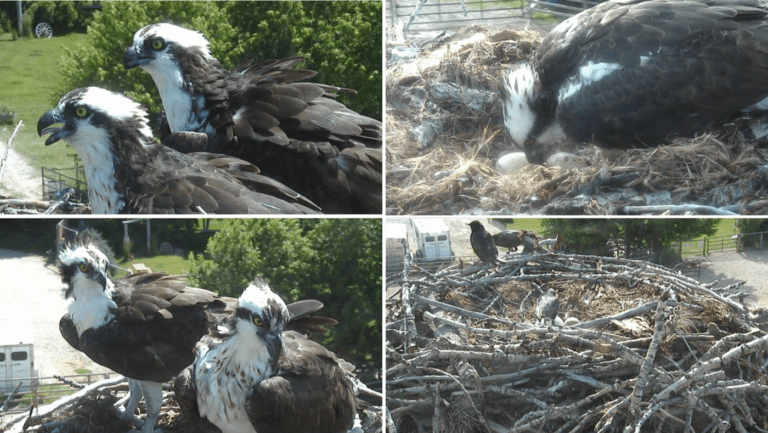
Dunrovin replaced the university’s web camera with our own, high definition pan tilt zoom camera and installed an ambient microphone. We also took over the camera operations, partnered with Cornell University to broadcast our web camera their web site that featured a Twitter chat feature. Hundreds of thousands of viewers found us via Cornell and we began to engage with many of them via Twitter.
Everything was set for a season of viewing, but alas it turned out to be a very sad year for Ozzie and Harriet. They returned in late March and immediately set about nest building and mating. Their two eggs appeared in mid-April and everyone got very excited. Due to hatch near the end of May, thousands kept waiting to see a pipe, and we all kept waiting and waiting and waiting. Harriet and Ozzie’s eggs never did hatch. It was heartbreaking to watch the adults tenderly turn and sit the eggs, days, weeks after they should have hatched. They remained dedicated to those eggs for the better part of June, only reluctantly abandoning them. Harriet and Ozzie stayed in the area until early September, and then departed for their winter homes.
No one knew why. The University of Montana retrieved the one egg that was left in the nest at the end of the year to see if they could determine the cause. It was totally empty, indicating an infertile egg.
Sad to see Harriet and Ozzie depart as the summer season closed, everyone was already looking forward to the next year with high hopes for better success.
2013

Thousand gathered around the nest on Cornell's web site that featured a Facebook plugin. We installed an infrared night light above the nest which neither humans nor birds can see but everything is visible through the camera. This gave all of us new perspective on the birds' activities.
It was a joyous year, but also one of many trials. The first of Harriet and Ozzie three eggs was laid immediately before an unseasonably winter storm that froze Harriet's face and covered her with snow. Luckily, our inferred light enabled us to witness Ozzie relieving her of her duties during the night. When she got up to give him the egg, it was surrounded by warm and dry duff and perfectly safe. Two eggs followed, and this time all three eggs hatched. Hurrah! Dunrovin asked its many viewers to help it pick appropriate names for these darling little chicks. The most popular names proved to be Percy (for perseverance), Hope, and Dilly (for diligence).
There was little competition between the three chicks. Ozzie was able to deliver fish after fish to feed them all and they thrived. As if to punctuate the terrible winter storm that spring, the temperatures rose to over 100° under a relentless bright sun. For hours on end, Harriet spread her wings and stood silently with her back to the sun to provide shade for her growing chicks, who could barely fit all their three heads under her skirts. Nothing could stop Harriet from protecting her brood, not the ice of spring nor the oven of summer.
Again, the University of Montana scientists banded all three chicks, which later enabled us to keep track of at least one of them. Dilly was later seen on the Hellgate osprey nest web camera during the summer of 2015. Unfortunately, early in 2016, Dilly was killed by a car on the highway just north of Dunrovin. He had a fish in his talons. He was probably trying to gain altitude when he was struck by the car.
2014
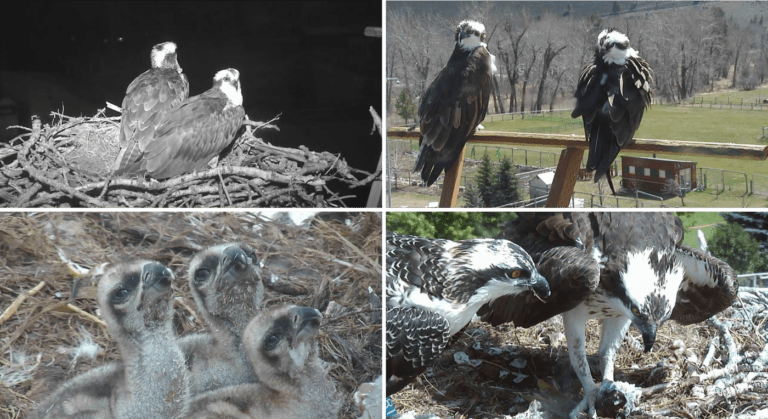
We installed a perch at the nest that we hoped would lure the adults into staying within view - and boy, has that perch paid off! We were a little concerned that the perch could actually deter Harriet and Ozzie from using the nest, so we held our breaths and crossed our fingers as late March arrived.
Harriet showed up before Ozzie as usual. About a week after her arrival, I was walking between my office and the ranch office towards the ospreys' nest, when I heard Harriet chip, chip, chip. I looked up and saw Ozzie doing his mating dance in the sky. What a sight and what a privilege to witness. He would circle higher and higher in the sky, then free fall towards the nest and swoop off at the last minute. He did this several times before landing, both birds chirping the entire time.
Harriet and Ozzie three eggs that season were all laid near the Lunar eclipse, so when the three chicks hatched, a D@D member suggested naming them Lunar, Sol, and Shadow. We all toasted their hatching. Everything seemed to be going beautifully for another successful year like the last.
But is was not to be. First, eagles relentlessly attacked the nest. Then a fierce summer storm hit, raising and clouding the water of the Bitterroot River and preventing Ozzie from securing sufficient food. Shadow died. But that was not the worst. It came in mid-August; an eagle killed Ozzie while he was fishing. We recovered his body and took it to Montana Fish, Wildlife, and Parks. They had him mounted and installed at their Montana Wild Education Center in Helena. Harriet understood. She stayed long after her normal migration date to feed her remaining two chicks until they all migrated south.
All of us viewers felt drained and disheartened as 2014 ended. As I look back on 2014, I thank God for having seen Ozzie in his last mating display. It will never leave my memory. He was a magnificent bird, an equal partner to Harriet, and truly the only osprey in the world to do his famous "wing lift" to get Harriet off the eggs so that he could site them. He was one of a kind. We all miss him still.
2015
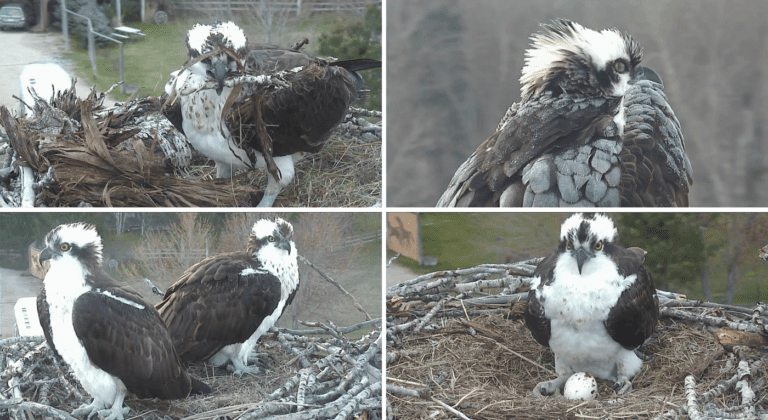
None of the viewers knew what to expect. How difficult would it be for Harriet to find a new mate? How could he possibly be as good as Ozzie? Would she return at all?
Return she did, and right on time at the end of March. She spend almost the entire month of March fixing up the nest and waiting, just waiting, seeming so alone. John Ashley took the incredible photo that serves as the backdrop to this article in April 2015. Harriet is sitting on her nest, looking and waiting, with the brilliant sun at her back and the wind in her feathers. It perfectly captures why she truly is our wonder woman hero. Regardless of the circumstances, she pushes forward, always trusting in life itself. Never does she give up. She just waits and always conquers what comes her way.
When May arrived, it seems like Harriet had placed a Craigslist ad reading "beautiful osprey widow with real estate looking for a new mate." In one wild, wild weekend no fewer than six different male ospreys came courting. In all of the frenzied activity, Harriet laid three eggs, one early on that one male pushed out, then another that was destroyed, and a third that ended up exploding at the nest form the heat. It was clear to all of us that the eggs didn't have a chance from the get go. Lacking a mate, Harriet would have to get up from incubating them, fly off to catch a fish, and leave them unattended until she returned. However, the final eggs ended up playing a significant role in the season.
After cycling through a number of mates who just didn't get the picture, Harriet finally selected a new mate that stuck with her. We named him Hal (for Hallelujah, Harriet had a mate). At times, we called him Hapless Hal, as he was obviously inexperienced and a little clumsy. He couldn't get the mating game right. He had to be nagged into getting Harriet a fish, and you could almost watch his dismay at trying to sit on the infertile egg. That egg proved its real worth in 2016. Hal did learn to sit on it' he did learn to fish for Harriet; and he finally learned all the intricacies of the mating games. However, we viewers didn't really see the results of his attending Harriet's summer school until 2016.
2016

Harriet returned to a nest that a certain someone else had taken a fancy to. Mrs. Great Horned Owl seemed very interested in the nest. Visible through via our night light and photographed my our web camera, we all worried about what would happen when Harriet returned. And, indeed, our worrying was not unjustified. A few nights after Harriet had returned, the owl was caught on camera swooping in on Harriet as she slept on the perch and completely knocking her off. Mrs. Owl could easily have killed Harriet with such a blow. To all of our relief, Harriet immediately returned to the nest and the owl was never seen again.
Soon after Harriet arrived, a male osprey moved in - but it wasn't Hal. Where was Hal? Well, he was not far behind and immediately displaced the interloper. Harriet and Hal then set about nest building, mating, and settling in for the season. Their two eggs were laid during the latter part of April, and the two chicks hatched on Memorial Day and shortly after, earning them the names of Honor and Glory.
It is mid-September as I write this, and Harriet, Hal, Honor, and Glory have all headed south to their winter homes. May their wings carry them far to fertile waters with plenty of fish. May Harriet, our wonder woman osprey, return to Dunrovin with Hal in tow to begin another successful breeding season.
2017
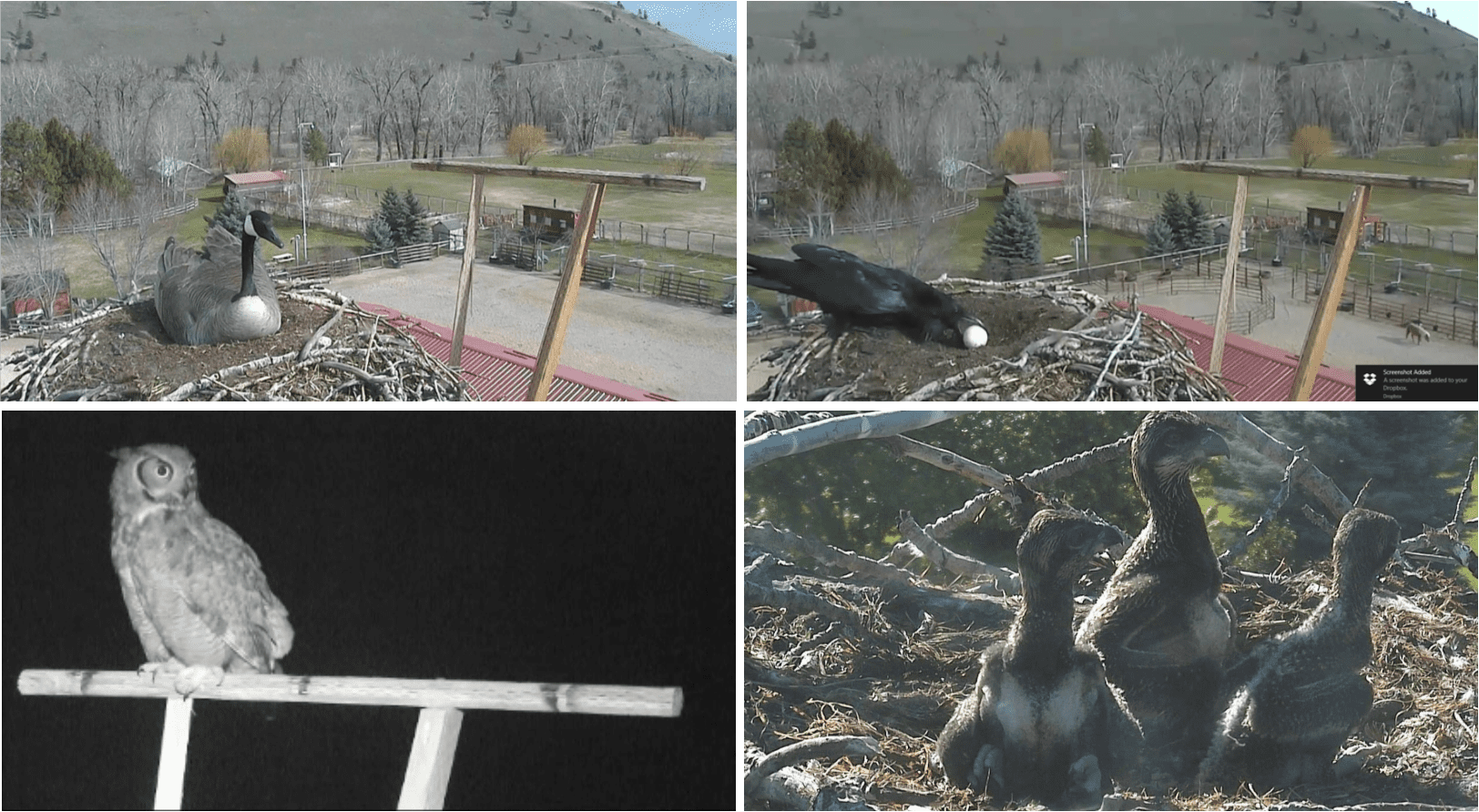
What a dramatic start! Harriet returned right on time during the first week of April. Within minutes of her landing, then taking off to catch and fish and get some much needed rest after the long migration, she returned to the nest to find a female Canada Goose who had laid an egg. While all of the Dunrovin Ranch staff on the ground fretted and made noises to discourage Mrs. Goose, it was all to no avail. However, Harriet didn't ask Mrs. Goose to politely abandon her egg, she simply dive boomed her and the goose quickly exited, leaving her egg behind.
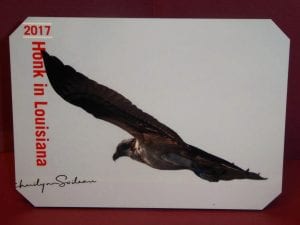 Lacking a hand with an oppose-able thumb to pick the goose egg up and toss it out of the nest, Harriet unsuccessfully tried to roll it out. It snowed, covering both Harriet and the goose egg. It seemed that Harriet was doomed to having a goose egg in her nest for the entire summer. However, while out on a fishing trip, Mr. Raven came sneaking around the nest, checked to see if he might be caught, and quickly grabbed the egg and departed. Problem solved!
Lacking a hand with an oppose-able thumb to pick the goose egg up and toss it out of the nest, Harriet unsuccessfully tried to roll it out. It snowed, covering both Harriet and the goose egg. It seemed that Harriet was doomed to having a goose egg in her nest for the entire summer. However, while out on a fishing trip, Mr. Raven came sneaking around the nest, checked to see if he might be caught, and quickly grabbed the egg and departed. Problem solved!
Later that night, Mrs. Great Horned Owl, knocked Harriet from her perch. Yet another big scare! Viewers were ringing their hands with all the drama that was happening within the first three days of Harriet's return - and still no Hal in sight. Finally, Hal did return and the season settled down. Harriet and Hal laid three eggs and three chicks hatched. We decided to honor the chaotic start to the year by naming the three chicks, Honk (for Mrs. Goose), Hero (for Mr. Raven), and Hoot (for Mrs. Great Horned Owl).
Unfortunately, summer storms caused the river to flood and food was insufficient to keep all three chicks thriving, and Hoot died in early July. The other two successfully fledged and departed in early September. The wonderful surprise was that in late November, Dunrovin Ranch received a lovely photo from bird photographer Cheri Lynn Soileau of Honk flying off the coast of Louisiana.
2018

Harriet and Hal returned right on time, got down to the business of mating, and laid three eggs. During May while they were incubating their eggs, Dunrovin sponsored a school science project called Awesome Ospreys in which students collected data to study the difference between the brooding behaviors of Harriet and Hal. The study showed that about 70% of the eggs incubation and brooding is done by Harriet. The fourth grade class from St. Joseph's Elementary School participated and were so enthusiastic about the project that they convinced their teacher to bring them all out to Dunrovin Ranch to see the nest. When the eggs hatched, we decided to let these fourth grade students name the chicks. They selected Congo, and Jambo in honor of a a new student who moved to Missoula as a refugee from the Congo. The local TV stations did a broadcast about their participation in the naming.
It was clear within a couple of weeks of hatching that the two oldest chicks began to completely dominate the youngest. At first, Hal was able to bring sufficient food so that once the two older chicks were stuffed, the youngest, Jambo, was able to get enough to thrive. However, within a few weeks, summer storms flooded the Bitterroot River, and the number of fish brought to the nest fell from over five per day to less than two. The chicks rates of growth during this critical period is such and they cannot survive long without food. To everyone's sadness, the youngest chick died.
Luckily, the two older chicks not only survived, but thrived once the river's waters subsided. With dark feathers appearing on the breast and by their large size, we judged them to be two females. Perhaps we should say two FEISTY females. These two fought over nearly every fish that was brought to the nest. The tug of wars would last for minutes, and often would end with a fish going over the side of the nest. This pattern was so prevalent that the fox family that we living in the area leaned to look for food under the nest. On more than a few mornings, our webcam viewers would see several foxes lined up under the nest waiting for a fish breakfast. Take a look at this video of one such morning!